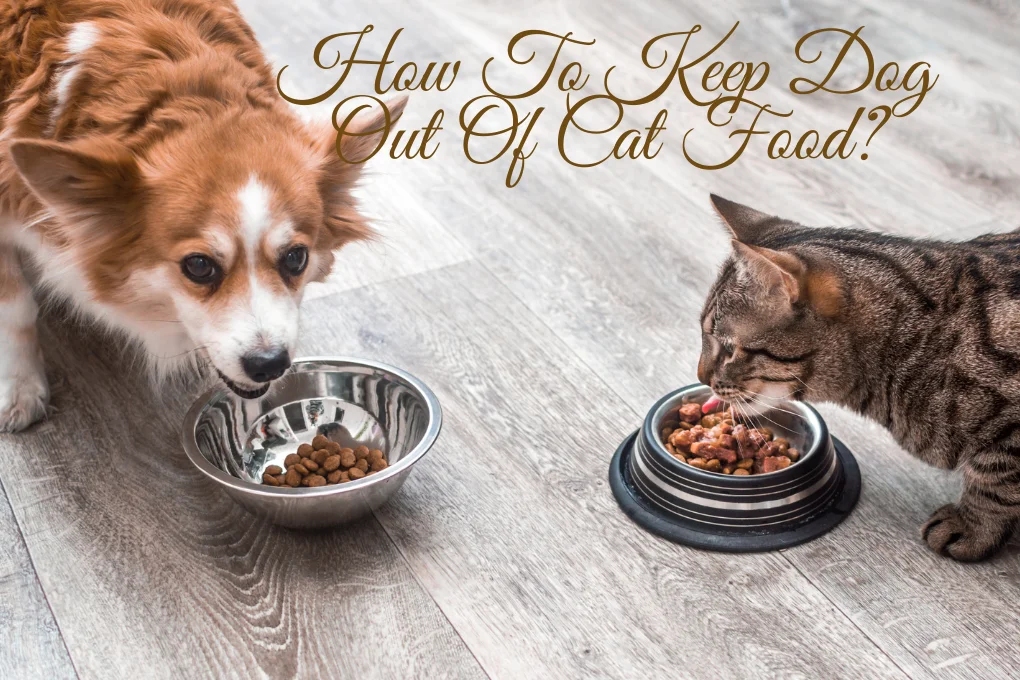As pet owners, we cherish the delightful personalities of our furry friends. However, one challenge that often baffles us is the constant battle to keep our dog out of the cat food bowl.
Today, I’m sharing my battle-tested insights on how to keep your dog away from cat food.
In this article, I’ll discuss the finer points of this common problem and explore effective strategies to keep our canine companions away from feline feasting.
Table of Contents
How To Keep Dog Out Of Cat Food? 7 Ways
Cat food possesses a unique aroma distinct from dog food, making it an enticing delicacy for your canine companion.
However, indulging in cat food frequently results in dogs experiencing diarrhoea and upset stomachs. This is attributed to the higher protein content in cat food than dog food, causing regret for your dog’s culinary exploration in the wrong feeding territory.

Despite the potential ill effects, some dogs relish sampling from every available dish, irrespective of the consequences.
Here are 7 effective strategies to deter dogs from accessing cat food to prevent such dietary mishaps.
1. Elevate the Cat Feeding Area
Elevating the cat’s feeding area serves a dual purpose: it provides a haven for your cat and adds an element of challenge for the dog.
Consider placing the cat’s food and water bowls on a sturdy cat tower or a designated elevated platform. This keeps the cat’s dining space dog-free and offers a sense of security for your feline companion.
2. Install Pet Gates
Pet gates are a practical solution to create designated spaces for each pet.
Opt for gates with cat-sized openings to allow easy access for your feline friend while preventing your dog from reaching the cat’s food.
This ensures that both pets can coexist peacefully in shared spaces without mealtime conflicts.
3. Establish Feeding Schedules
Establishing consistent feeding schedules for your cat and dog is a simple yet effective strategy. By feeding them at separate times, you can closely supervise each meal.
This helps prevent your dog from raiding the cat’s food and ensures that both pets receive the attention and care they need during mealtime.
4. Use Automatic Cat Feeders
Invest in technology to maintain order during mealtimes. Automatic cat feeders with microchip recognition or RFID technology only open when the designated cat approaches.
This innovative solution adds an extra layer of security, ensuring that your dog cannot indulge in the cat’s meal while satisfying your cat’s dietary needs.
5. Teach Obedience Commands
Basic obedience training can go a long way in managing your pets’ behavior. Train your dog with commands such as “stay” and “leave it” to instil discipline during mealtime.
This training empowers you to control your dog’s movements, preventing unwanted intrusion into the cat’s eating space.
6. Create Separate Eating Spaces
Designating specific areas for your cat and dog to eat is a straightforward yet effective approach.
Whether it’s different rooms or distinct corners of a shared space, clear boundaries ensure that your cat can enjoy a peaceful meal without the looming presence of your dog. This separation fosters a stress-free environment for both pets.
7. Supervise Mealtime Interactions
Active supervision during mealtime is crucial to reinforce positive behavior and address potential conflicts.
If necessary, stay vigilant and intervene to create a harmonious meal environment for your cat and dog.
Positive reinforcement and attentive supervision establish a routine where both pets can coexist without disruptions during their respective meals.
Why Does My Dog Eat Cat Food?
Cat food is formulated to smell good and taste good. This is why dogs become addicted to this delicious food.
When your dog dives into the cat’s food bowl, it’s not just a quirky habit. Dogs are drawn to cat food because it’s richer in fat and protein. My pup, for instance, can’t resist the aroma and flavors.
Cat food often has higher calorie content, making it an enticing dog treat. Their instinctual preference for meaty goodness explains this culinary curiosity.
In my experience, it’s crucial to establish separate feeding areas and maintain consistency in feeding schedules to deter your dog from making feline feasts a routine.
Understanding your dog’s natural inclinations can help you effectively address this common canine culinary caper.
Is Cat Food Bad for Dogs?
Occasionally, feeding your dog or cat food won’t harm them, but it’s not ideal. Cat food lacks essential nutrients that dogs need.
My pup, for instance, loves the taste, but it’s not a balanced diet for him. The higher fat and protein levels can lead to weight gain and digestive issues.
In my experience, regular consumption may cause long-term health problems. Stick to dog food tailored to their nutritional needs.
If your dog sneaks a bite, it’s no emergency, but make sure it’s not a dietary habit. A balanced diet designed for dogs ensures their overall well-being.
How to Stop Your Dog from Eating Cat Food?
I took a few effective steps to prevent my dog from raiding the cat’s food stash.
First, I elevated the cat’s feeding area; dogs find it harder to reach.
Second, I set clear boundaries, designing separate pet dining zones. Consistent feeding schedules also discourage my dog from exploring the forbidden kibble.
Investing in pet barriers and using automated feeders with selective access proved invaluable. Supervising meals and positively reinforcing good behavior helped train my dog to respect boundaries.
Lastly, strategically placing the cat’s bowls in less accessible spots further deters my curious canine. Combining these strategies ensures a dog-free dining experience for my feline friend.
What Is The Difference Between Cat Food And Dog Food?
Cat food and dog food may seem similar, but key differences cater to the distinct nutritional needs of each species.
Protein Content:
Cat food typically has higher protein levels to meet the predatory nature of cats. While carnivores also have different dietary requirements, dogs can thrive on slightly lower protein levels.
Taurine Requirement:
Cats require taurine, an amino acid, as they can’t produce it adequately. Dog food may not have enough taurine for cats, making it crucial for them to consume cat-specific food.
Nutrient Profile:
Cats need certain nutrients like arachidonic acid, which is not essential for dogs. Dog food may lack these specific nutrients crucial for feline health.
Fat Content:
Cats need more dietary fat than dogs. Cat food often contains higher fat levels to support their energy needs.
Vitamin A:
Cats cannot convert beta-carotene into vitamin A as efficiently as dogs. Cat food is supplemented with pre-formed vitamin A, whereas dog food relies on beta-carotene.
Texture and Shape:
Cats often prefer smaller, more aromatic kibble with a texture that suits their dental structure. Dog food may have larger, crunchier pieces.
While some dogs may nibble on cat food without harm, meeting each pet’s specific dietary requirements for optimal health is essential. Always consult your veterinarian to choose the right food for your furry friend.
FAQs
Can I train an older dog to stay away from the cat’s food?
Yes, with patience and consistency, older dogs can learn new behaviors through positive reinforcement.
Are automated feeders safe for pets?
Yes, reputable automated feeders with safety features are designed to provide secure and controlled access to pet food.
What if my cat and dog share the same food?
It’s advisable to consult with your veterinarian to ensure both pets receive appropriate nutrition without compromising their health.
Conclusion
How To Keep Dog Out Of Cat Food? A combination of techniques catered to the individual personalities of your pets and the dynamics of your home are needed to keep your dog away from the cat’s food.
Many approaches exist, from physical barriers and training techniques to innovative products and homemade remedies.
You may establish a peaceful setting where your cat and dog can eat together without disruptions by using these techniques regularly.

Hi there! My name is Koushik; I am a cat lover. I specialize in writing about pet care & food. I have a wealth of knowledge on cat food niches and related subjects. I have worked in the pet industry for over 5 years and am passionate about helping cat owners provide the best care for their furry friends. With knowledge of cat food and nutrition, I aim to share their insights and help cat owners navigate the world of cat food niches. I enjoy playing with my two cats, reading, and exploring new cat food brands in my free time.